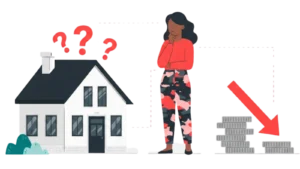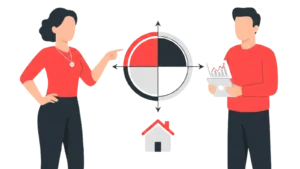Updated : Aug 25, 2025
Imagine scrolling through endless vacation rental listings. One boasts a king-size bed, high-speed WiFi, and a sparkling pool just like dozens of others. Another, however, invites you into the story of a family lakehouse where generations have gathered to watch fireflies, roast marshmallows, and create lifelong memories. Which one draws you in? Simply listing amenities isn’t enough anymore. Travelers crave experiences and connections, not just a place to sleep. That’s where storytelling comes in. By weaving authentic, compelling stories into your short-term rental marketing, you transform your property from “just another listing” into a guest magnet to a place guests can picture themselves belonging. In this guide, you’ll discover why storytelling works, how to craft your unique narrative, and practical ways to use it across every touchpoint to attract more bookings.
Why Storytelling Matters in Short-Term Rental Marketing?
Storytelling isn’t just for novels or movies—it’s one of the most powerful tools in modern marketing. For vacation rental hosts, it’s the secret ingredient that transforms a list of amenities into a memorable experience.
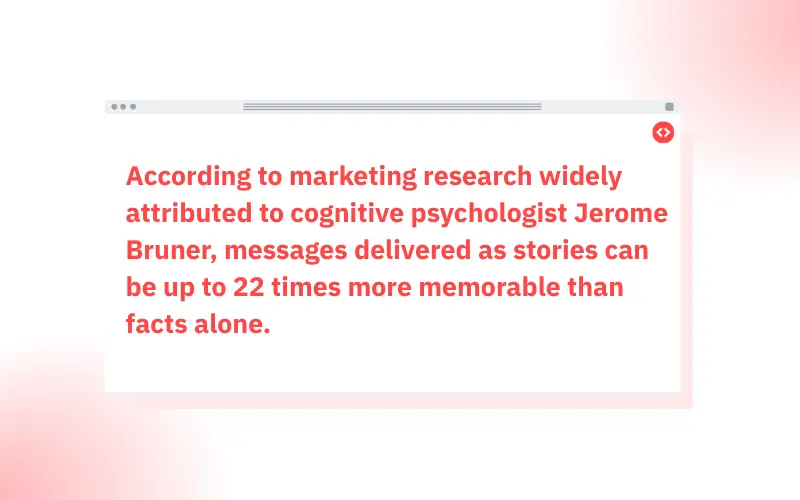
- Building Trust and Aspiration: A great story invites guests to imagine themselves in your space. Instead of seeing your listing as just another rental, they picture mornings with coffee on your sunlit balcony, or evenings spent by the fire. This emotional connection not only boosts engagement but often drives guests to book faster and at higher rates.
- Standing Out in a Crowded Market: With thousands of similar listings on Airbnb and Vrbo, a compelling narrative is your chance to stand out. Guests don’t remember listings—they remember stories. And the properties that stick in their minds are the ones that feel personal, inviting, and real.
Maximize Your Vacation Rental Return with Dynamic Pricing and Understand Your Portfolio Performance With Portfolio Analytics!
Boost occupancy & optimize revenue with PriceLabs’ Dynamic Pricing & Revenue Management tool. Implement a smart pricing strategy based on market conditions, seasonality & competition for excellent ROI.
Start Your FREE Trial NowThe Foundations of Storytelling for Hosts
Before you can start using storytelling in your short-term rental marketing, it’s essential to lay a strong foundation. This involves identifying your property’s unique aspects, understanding your ideal guest, and shifting your focus from listing features to sharing experiences.
1. Identify Your Vacation Rental’s Unique Narrative
Every property has a story—sometimes you just need to dig a little to find it.
Is your home a restored heritage villa, a modern apartment with city views, or a cozy mountain cabin passed down through generations? Maybe your journey as a host is itself compelling—did you start hosting to share your love of surfing, or to preserve a family retreat?
Write down three things that set your property apart: history, location, or even the quirks you love. Example: “Our lakeside cottage was built in the 1950s by my grandparents, and every summer since, our family has gathered here to celebrate togetherness and sunsets.”
2. Know Your Target Guest
Not all stories will resonate with everyone. Are you aiming to attract families, couples, solo travelers, or digital nomads? Knowing your audience helps tailor your story so it feels personal and relevant.
Example Persona:
- “Imagine waking up here as a remote worker—coffee on the balcony, strong WiFi for video calls, and a sunset swim to end your day
- “For families, our backyard treehouse and s’mores-ready firepit make for unforgettable evenings.”
3. Highlight Experiences, Not Just Features
The features of your rental (bedrooms, WiFi, pool) matter—but what truly draws guests in are the experiences those features enable. Rather than simply stating “3 bedrooms, fast WiFi, and a grill,” paint a picture:
“Gather your loved ones for a barbecue on the deck while the kids play in the garden. Share stories around the firepit after a day exploring nearby trails.”
This approach helps guests envision themselves making memories at your property, not just occupying space.
Pro-Tip: By shifting your focus from things to experiences, you unlock the emotional appeal that makes your listing unforgettable.
Practical Ways to Use Storytelling in Your Short-Term Rental Marketing
Storytelling can and should be embedded into every guest touchpoint, both online and offline. Here’s how to apply it across your entire marketing strategy:
1. Listing Descriptions: Make Every Word Count
Your listing is your first (and sometimes only) chance to make an impression. Storytelling transforms generic descriptions into vivid invitations.
- Start with a scene: Open with a “moment” rather than a list.
Example: “Step into a sunlit kitchen where you can sip fresh coffee as the city wakes up outside your window.” - Highlight transformation: Describe how guests might feel before and after their stay.
Example: “Arrive as strangers—leave as friends, with memories of bonfires, laughter, and starlit evenings.” - Weave in your property’s personality: Is it quirky, modern, tranquil, or historic? Let that flavor show in your language.
- Connect amenities to experiences: Example: “Enjoy a movie night in our cozy living room with plush throws and an old-school popcorn maker.”
Pro-Tip: Use the “Show, Don’t Tell” approach. Instead of saying “romantic getaway,” describe the candlelit dinners on the terrace or the secluded garden bench perfect for two.
STRings: Airbnb Description Generator is a powerful tool that employs Artificial Intelligence to generate compelling, relevant, and best Airbnb descriptions for your listing within seconds.
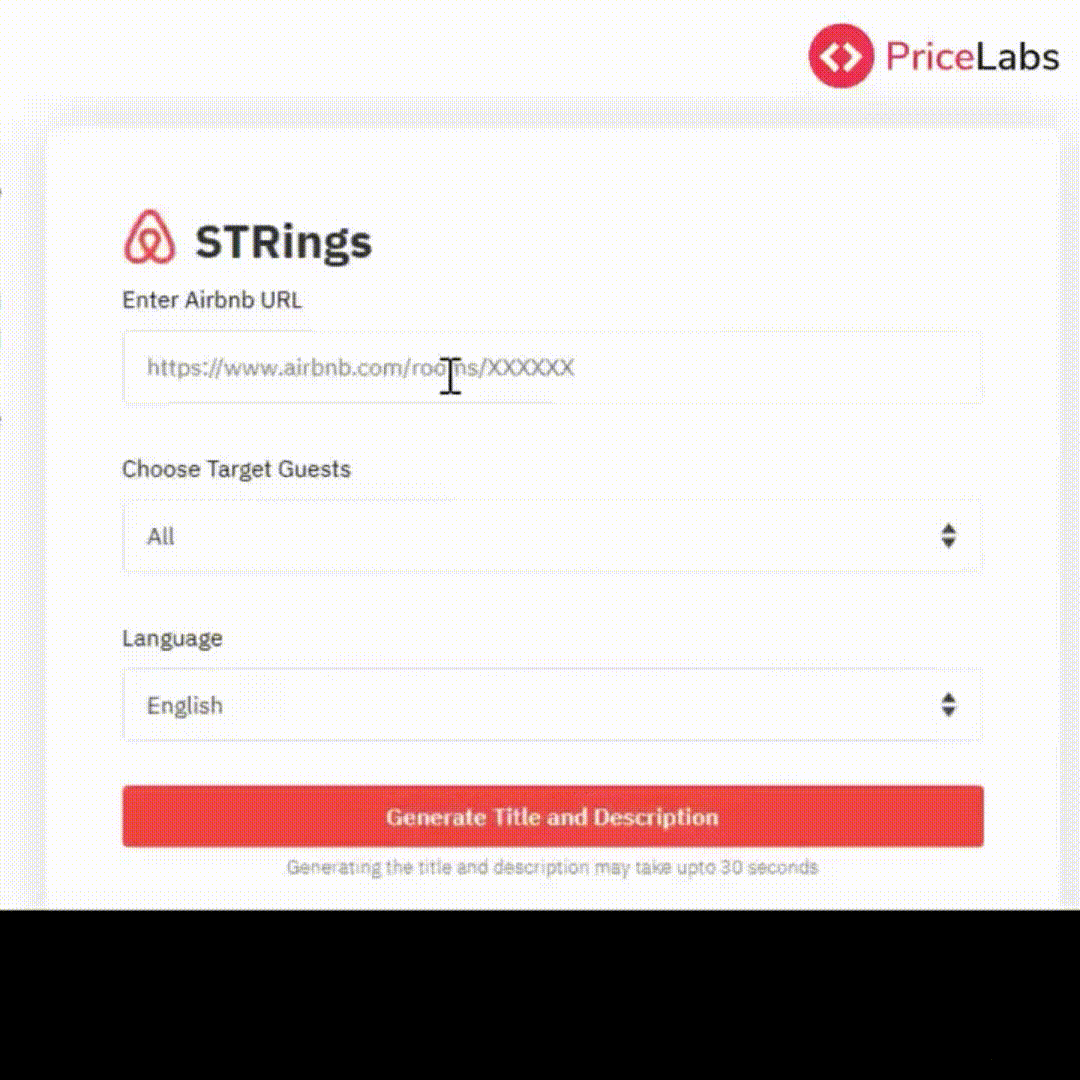
2. Visual Storytelling: Photos, Videos & Captions
A single Airbnb photo can tell an entire story, but only if you curate intentionally.
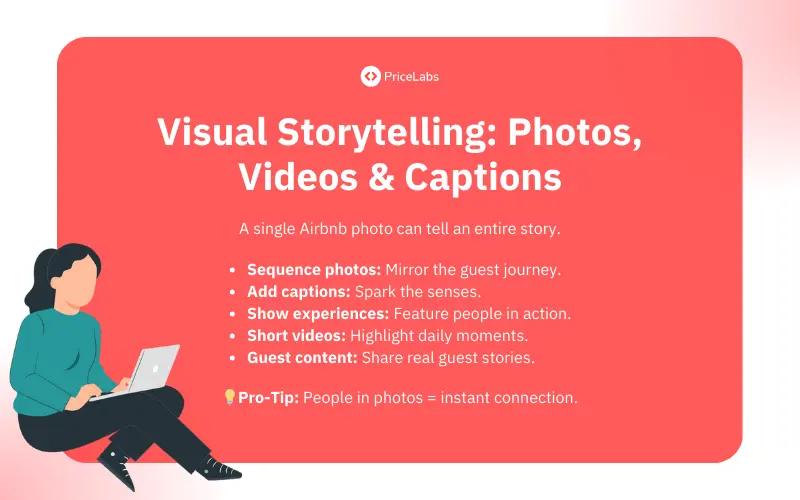
- Sequence your photos: Arrange images to mirror the guest journey: arrival, first impressions, communal spaces, cozy corners, outdoor adventures.
- Add captions: Brief, sensory captions help guests imagine moments.
Example: “Sink into the hammock with a good book as the breeze rustles the palms.” - Show experiences in action: Feature guests (with permission), families at dinner, kids playing, a dog curled by the fireplace, a picnic set up in the garden.
- Leverage short-form video: Create 30-second “day-in-the-life” reels or room tours, highlighting moments (e.g., “Morning coffee with sunrise views”).
- Use user-generated content: Repost guests’ stories, reviews, or photos on your listing and social channels.
Pro-Tip: Photos of people enjoying your space create an instant emotional hook—far more than empty rooms.
3. Social Media: Build Your Property’s Ongoing Narrative
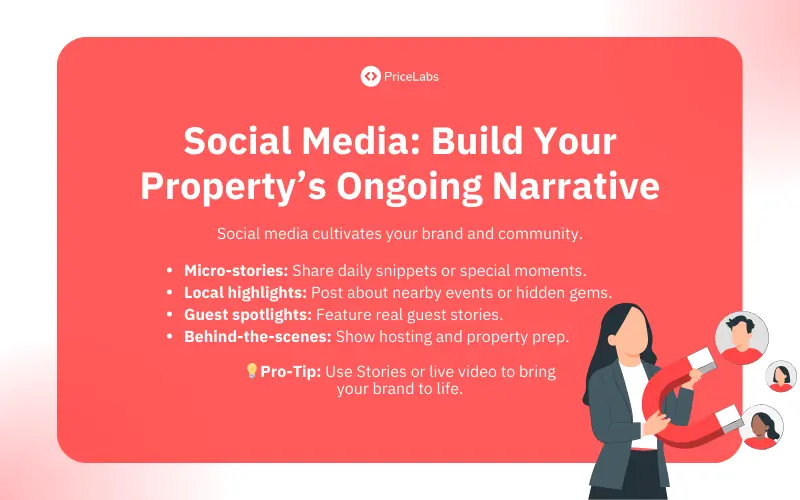
Social media isn’t just for advertising availability; it’s a place to cultivate your brand and community.
- Tell micro-stories: Share snippets—“The first snow of the season at our mountain cabin,” or “The story behind our hand-painted mural.
- Highlight local stories: Post about nearby festivals, local legends, or must-visit cafés.
- Run guest spotlights: Feature stories or testimonials from past guests (“Meet the Smiths, who celebrated their anniversary here…”).
- Behind-the-scenes: Show your hosting process, preparations, or little upgrades—humanizing the brand.
Pro-Tip: Don’t just post photos—use Instagram Stories, Facebook Live, or TikTok to narrate your day, answer questions, or walk viewers through the property in real-time.
4. Direct Booking Website & Email: Reinforce Your Story Everywhere

Your direct booking website and guest emails offer more room to tell your story in depth and maintain consistency.
- “Meet the Host” pages: Share your journey, values, and why you started hosting.
- Story-driven blogs: Write about how your home came to be, renovation tales, or memorable guest experiences (with consent).
- Email nurture sequences: Welcome emails can include a brief personal story, a favorite local memory, or a tip tied to your property’s theme (e.g., “Our favorite sunrise spot is just a five-minute walk away”).
- Brand voice: Carry your unique tone into every guest interaction—confirmation emails, FAQs, guidebooks.
Pro-Tip: Add downloadable guides, such as “Our Family’s Favorite Hiking Trails,” to further anchor your story in the local context.
5. Offline Touchpoints: Make Storytelling Part of the Guest Experience
- Welcome notes & guidebooks: Open with a story or anecdote—why you love the home, a fun fact about the area, or a “hidden gem” you discovered.
- In-property signage: Frame instructions or tips with personality (“This old oak tree is where our kids built their first treehouse!”).
- Guestbooks: Encourage guests to share their own stories, which can be highlighted (with permission) in future marketing.
Pro-Tip: Storytelling continues during and after the stay. Guests who feel connected to your property’s story are more likely to leave heartfelt reviews and return for future visits.
Every part of your marketing—from the listing and photos to emails and in-person touches—can be infused with story. Start small, be authentic, and build layer by layer for a brand guests will remember.
Storytelling Across the Guest Journey
Great storytelling doesn’t end with your listing—it can be woven through every step of the guest’s experience, creating deeper connections and higher satisfaction. Here’s how to embed your narrative before, during, and after each booking:
Pre-Booking: Attraction and Inspiration
- Listings, ads, and social media: Make your story the reason guests choose your property. Instead of “Book now!”—inspire them with “Create your own lakehouse memories,” or “Experience the town’s best sunrise from our balcony.”
- Personal responses to inquiries: When replying to guest questions, use the opportunity to reinforce your narrative. For example, if someone asks about local restaurants, share a personal favorite or a story about a memorable meal you had nearby.
Booking Stage: Personalized Confirmation
- Confirmation emails: Don’t just send a receipt—send a welcome message rooted in your story. Example: “We’re thrilled you chose our mountain retreat, where our family has gathered for winter holidays for decades. You’ll find hot cocoa in the kitchen—a family tradition we hope you’ll enjoy.”
- Share anticipation: Build excitement with a preview of what’s to come, such as a story about the area, a favorite trail, or a tradition guests can experience during their stay.
During the Stay: Immersive Touchpoints
- Welcome letters and house manuals: Open with a warm note about the property’s history, your hosting philosophy, or a local legend. Example: “This fireplace was built with stones from the original cottage. On cold evenings, we love to curl up here with a book—please help yourself to our little library.”
- Local guides and tips: Frame recommendations as stories: “This bakery has been family-run for three generations—try the almond croissants, just like we do every Sunday.”
- Small surprises: If you provide a treat or a special amenity, tie it back to your story (e.g., “The homemade jam in your welcome basket comes from the apple trees in our backyard.”)
Post-Stay: Encouraging Connection and Loyalty
- Thank-you emails: Reference their unique stay and invite them to return (“We hope your family enjoyed the board game collection—it’s brought us many rainy-day laughs!”)
- Review requests: Ask guests to “share their story” in their review, encouraging richer and more detailed feedback.
- Stay-in-touch campaigns: Send occasional updates: “This spring, we added a hammock by the lake—can’t wait for you to try it on your next visit!”
Final Thoughts: Turning Your Property into a Guest Magnet
In a world where travelers have endless choices, the difference between a forgettable listing and a guest magnet often comes down to one thing: story. By weaving storytelling into every aspect of your short-term rental marketing—from your online listings and social media to the welcome notes your guests find on arrival—you create a property that feels alive, memorable, and inviting.
Storytelling isn’t about inventing tales or making empty promises. It’s about revealing the real experiences, values, and personal touches that make your space special. Start small: rewrite a listing intro, add a heartfelt caption, or share a favorite local tip. Over time, these authentic stories build a brand guests want to be a part of—and return to.
So, embrace your property’s narrative. Share it boldly, consistently, and across every channel. In doing so, you’ll transform not only how guests see your space, but also how you see your own journey as a host.
FAQs on Storytelling & Short-Term Rental Marketing
1. How can I market my vacation rental property effectively?
The most effective short-term rental marketing combines compelling storytelling with professional photos, optimized listings on platforms like Airbnb and Vrbo, and consistent branding across social media, email, and direct booking websites. Focus on sharing your property’s unique story and guest experiences—not just amenities—to stand out and attract bookings.
2. Where should I share my vacation rental’s story?
Share your story everywhere guests interact with your business: listing descriptions (Airbnb, Vrbo, etc.), photos and captions, social media posts, your direct website, pre-arrival emails, in-house welcome materials, and even in guest review requests. Consistent storytelling across these channels creates a memorable and cohesive brand.
3. What are some easy storytelling ideas for my short-term rental marketing?
Start with these quick wins:
- Open your listing with a guest-centered moment.
- Add captions to photos that evoke emotion or describe experiences.
- Include a personal welcome note.
- Share a favorite local legend or tip in your guidebook.
- Highlight guest stories in your marketing (with permission).
4. Can I market my vacation rental home on multiple sites?
Yes! You can (and should) market your vacation rental on platforms like Airbnb, Vrbo, Booking.com, and your own direct site. Just ensure your core story and brand remain consistent, even as you adapt your narrative and photos to fit each platform’s style and requirements.
5. How does storytelling increase bookings for my vacation rental?
Storytelling creates an emotional connection that makes your property memorable and desirable. According to marketing research, stories are up to 22 times more memorable than facts alone. When guests can picture themselves making memories at your property, they’re more likely to book—and more likely to return.









